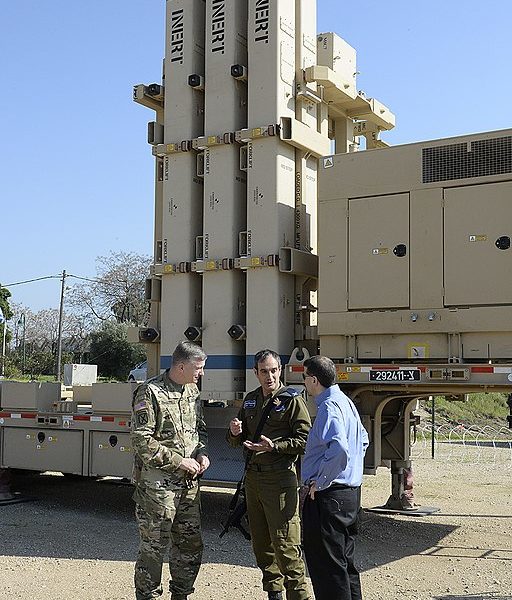U.S. Embassy Tel Aviv, CC BY 2.0 <https://creativecommons.org/licenses/by/2.0>, via Wikimedia Commons
U.S. President Joe Biden recently ordered airstrikes against Iranian-backed militias, but that failed to stop them from rapidly escalating their rocket and drone campaign to drive the United States out of the Middle East. Last week the U.S. embassy in Baghdad came under multiple assaults as part of a larger acceleration of Iranian proxy attacks throughout the region. It’s little wonder: The Biden administration has invited this escalation by withdrawing vital air defense systems from Iraq, Saudi Arabia and other Middle East nations.
Rather than retreating, American needs to enhance our regional partners’ offensive and defensive capabilities. This requires a serious strategy based on stronger, consistent and more concerted U.S. military force to deter and eliminate these growing threats. Iranian-linked missiles, rockets, mortars and drones continue to be the most frequent threats to U.S. personnel, partners and interests in the Middle East.
The number of these munitions that groups in Iraq, Yemen and Syria have fired at U.S. service members, partners and interests, like vital oil facilities, have roughly doubled each year since 2018, according to data compiled by the Jewish Institute for National Security of America. The 228 projectiles used during 64 separate attacks this year are on pace to set a new annual record.
In particular, these groups increasingly use armed drones with maneuverability that poses a challenge for current air defenses. Compared to 2018-2020, when drones represented only 19 percent of the munitions Iranian proxies used, these weapons now account for 58 percent of the projectiles these groups launch against U.S. personnel, partners and interests.
Though President Biden has retaliated twice with airstrikes, on Feb. 25 and June 27 of this year, Iraqi militias nevertheless have launched 30 attacks on U.S. personnel in Iraq since Biden took office — including firing 46 rockets and drones against Americans in Iraq between the February and June U.S. strikes. This data underscores how the Pentagon’s current deployment of air defenses in the Middle East is insufficient and incapable of handling the ongoing threats.
America’s counter-rocket, artillery and mortar systems can intercept small numbers of short-range rockets and drones but are likely to struggle against the likelihood of increasingly large rocket salvos and drone swarms. Even so, the Biden administration is encouraging further proxy escalation and jeopardizing our partners’ security by reportedly withdrawing Patriot and Terminal High Altitude Area Defense systems from Iraq, Kuwait, Jordan and Saudi Arabia.
The rebalance of military assets is part of the Biden administration’s shift toward strategic competition with China and Russia, but it could encourage America’s regional partners to look to Beijing and Moscow as potential security guarantors if Washington downplays their enduring threats. The United States can offset its smaller military footprint by enhancing the existing International Maritime Security Construct of the U.S., the U.K., Saudi Arabia, the United Arab Emirates, Bahrain, Albania, Estonia and Lithuania to protect shipping lanes in the Arabian Gulf region and to thwart covert Iranian arms shipments.
U.S. Central Command must play a leading role by increasing its interdiction of Iranian weapons proliferation to Iraq, Yemen and Syria. Similarly, the United States should coordinate a new regional, multilayered early warning and air defense architecture that can guard against the broad arsenal of munitions Iran proliferates, focusing on the rising drone threat. This would enable Middle Eastern states to defend themselves more effectively and reduce the time necessary to identify and intercept incoming munitions.
New air defenses are also necessary to counter the shift toward drone attacks. America and its partners should boost joint research and development projects to devise new, cost-efficient “counter-unmanned systems” that can handle potential swarms of dozens or hundreds of drones.
Even as these efforts are underway, America must keep its remaining air defense systems in place until its regional partners can acquire and deploy sufficient alternatives. The U.S. Army should expedite the deployment of the two Israeli Iron Dome batteries it has acquired and is currently testing. The Department of Defense should also procure Israel’s medium- to long-range air defense system David’s Sling. Together, these two joint U.S.-Israeli systems can help fill the glaring gaps in current air defenses.
Finally, the United States should enable its trusted partners like Israel to deter and degrade Iranian capabilities on their own by accelerating the provision of precision munitions via foreign military sales. The Pentagon should also update its own currently obsolete supply of pre-positioned weaponry in Israel, called WRSA-I, to include Joint Direct Attack Munitions and precision-guided small diameter bombs.
The dangers posed by Iranian-linked projectile attacks throughout the Middle East requires a comprehensive U.S. strategy. Currently, America’s inconsistent use of military force and reduced air defense posture needlessly exposes the region to an increasingly radical Iran and its armed proxies. Biden may be looking to shift America’s national security focus elsewhere, but America risks being further drawn into the region unless he addresses the growing threat from Iranian projectiles.
Ari Cicurel is a senior policy analyst at the Jewish Institute for National Security of America.

